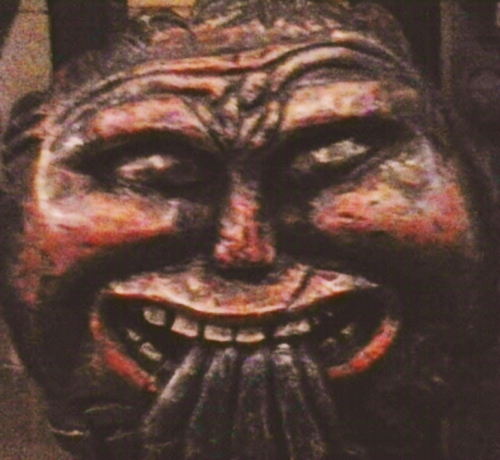
Jostein Gaarder: The Ringmaster’s Daughter
(original title Sirkusdirektørens datter 2001)
Translated by James Anderson
Phoenix 2003
The Baltic Sea is well known for its amber, solidified resin from forests around 44 million years old, and frequently trapped in these deposits are various flora and fauna of the period. The most striking image in The Ringmaster’s Daughter, which symbolises one of its major themes, is of a spider caught in this matrix, just like its victims might be caught in its web.
The story that gives the novel its title concerns a trapeze artist who falls and breaks her neck. As the ringmaster bends over her injured body he sees an amber trinket on a slender chain around her neck, which he recognises as one he had given to a daughter he hasn’t seen for years.
The importance of this tale of the lost daughter is underlined by it being told, with variations, three times during the course of the novel, in the presence of each of the three most important women in the narrator’s life.
The narrator is Petter. I don’t think we are told his family name, but he imagines himself as Petter Spider; this is the Norwegian nursery rhyme equivalent of Incey Wincey Spider, who gets washed away by a shower of rain but then re-ascends a hat (or spout in the English-language versions). The ending of this web-spinner’s tale is upbeat, leading one to expect The Ringmaster’s Daughter to have a similarly optimistic conclusion, but there is no guarantee that this will happen.
Tragedies have a typical profile when it comes to plotting their courses against success and time: an apparent rise in good fortune takes a disastrous dip, a rally being followed by a further descent towards failure (comedies tend to mirror rises with falls and vice versa). The profile of Gaarder’s novel appears to match the tragic model, but we are left in limbo by the end — will Petter untangle himself from the web he has woven and, like Robert the Bruce’s inspiration, try and try again? Or will the taboo he has unwittingly broken cause him, like Oedipus, to suffer the consequences for the rest of his life with no hope of redemption?
The root of Petter’s misfortunes arise as a result of childhood traumas. One, revealed near the beginning of the book, relates to his mother’s rejection of the first story he has ever composed — written on her bedroom wall; as a result he has vowed never to write a novel, to just stick to successfully peddling synopses and aphorisms, plotlines that pour out of him as a result of his wide reading and observation of people. The other trauma, the existence of which emerges towards the end of the novel (or biography, as this is how Petter the narrator sees it), gave birth to the Rumpelstiltskin-like leprechaun figure who haunts his waking life, an enigmatic homunculus whose origins Petter is understandably reluctant to fathom.
Gaarder is known as a writer who extensively utilises metafiction so that we can get confused if the primary world merges into a secondary or even tertiary world (as, for example, in The Solitaire Mystery): Jostein Gaarder writes a novel about Petter, who narrates tales about other individuals, including those whose roles feature in the novel’s title. Petter is born in Norway around 1952, as is Gaarder, and is successful as a spinner of tales, as is Gaarder, and travels to book fairs, as no doubt does Gaarder. But Gaarder is not Petter, his life appearing to have followed the graph allocated to comedy (if we accept the classical meaning of the word).
The frame of the story is set on the Amalfi coast, in the house where Gaarder’s compatriot Ibsen wrote A Doll’s House. I’m not familiar with this play (I supposedly studied The Pillars of Society and Hedda Gabler at school) so can’t comment on any relevance to The Ringmaster’s Daughter. But the one play by Ibsen that I’m reminded of is his Peer Gynt, which is not referenced in the novel but which has some interesting parallels to Gaarder’s novel. Both works share a name (Peer is a diminutive of Petter, the Norwegian form of Peter); both have elements of magic realism in that the real world and the world of the imagination coexist for both Peer and Petter; in both the protagonist has a liaison which results in an offspring whose arrival has grave consequences; each work has a being who is an aspect of the protagonist, the Bøyg for Peer, the homunculus for Petter.
And both works try to answer the question, what does ‘being yourself’ mean? The Troll King says that humans claim to live by the motto, Be true to yourself but that for trolls it is simply Be yourself! Petter’s life has epitomised a selfish troll-like existence; by the end he realises that he has to take responsibility for his attitudes and actions which have taken a human toll.
Like a spider’s web The Ringmaster’s Daughter throws out gossamer threads in all directions. Sometimes I muse on the plots of Puccini’s operas which are referenced here (and of course Puccini himself wrote operas virtually overlooking the same sea that Ibsen saw, though a little further north); other times I’m reminded of Shakespeare’s A Winter’s Tale which also features a lost daughter, Perdita; the tale synopses that punctuate the pages have the same bitter-sweet taste of the literary fairytales of Wilde or, particularly, Hans Christian Andersen, rather than driving inexorably to the expected ‘fairytale ending’ of traditional stories.
Only one thing I’m missing, and that’s a sense of the other people that Petter interacts with. All are seen through his eyes, of course, but because idealised or occasionally stereotyped they seem more like fairytale archetypes than rounded individuals. And probably that’s the point. His mother fails at being the ideal maternal figure, his hoped-for sweetheart refuses to be his anima, he is not to know his daughter, his only true creation; all humans are puppets on strings to be played with, victims enmeshed in a web. Perhaps all fiction writers are like this; maybe Gaarder’s metafiction is a meditation on the perils of playing God.
Repost of review first published 23rd December 2013, first of a short series of recycled reviews this month


One would need to read this to comment intelligently. Nevertheless I am reminded that while treatment defines the difference between comedy and tragedy – using the same elements – that between fairy tale and tragedy is usually a function of where one stops. I am not a fan of the stories that become none of these things, but simply meander into meaninglessness.
LikeLiked by 1 person
Thanks for the insight about the relationship of fairytale and tragedy — that’s quite profound and one that already has me ruminating.
As for stories that stop before the expected conclusion — whether fairytale ending or tragic denouement — Christopher Booker famously railed against these in The Seven Basic Plots. I don’t overly mind these in realistic novels (after all life is often messy, with few pat endings) but they can irritate when you are led by an author to expect a classic ending and then they fail to deliver.
The only time that seems acceptable is when a sequel is indicated: then you are right to anticipate loose ends to be tied.
LikeLike
I do agree that loose ends should be tied, or that it should be made clear that (true to the way life often is) they never do get tied up. Or used as a ‘teaser’ for the sequel. At least addressed; not simply left dangling pathetically.
I am in a minority of writers and readers (it would seem) who enjoy an ending which wallows in the success and happiness ultimately attained. I remember my irritation at the classic comic books (School Friend and the like) where the protagonists would go through all sorts of misery for edition after edition, but the happy conclusion would be wrapped up in one frame.
I also enjoy providing a final surprise or twist (which the fundis condemn as anticlimax) to follow the celebrations.
LikeLiked by 1 person
I’m much in sympathy with your point of view, Col — I couldn’t stand a diet of unresolved novels. I also like the idea of a surprise/twist after all’s apparently wrapped up.
LikeLike
Sounds like a very interesting and deep book. I’m intrigued by your statement: maybe Gaarder’s metafiction is a meditation on the perils of playing God.
LikeLike
Thanks for your appreciation! Gaarder is both writer and philosopher (he’s of course the author of Sophie’s World which brought philosophy to the general fiction-reading public) and all his novels that I’ve read deal with philosophical issues and the paradoxes and conundrums that arise from these issues.
The perils of playing God: all humans, artists of all types especially, are creators even if only on a very small scale. By peddling his extremely successful story synopses anonymously to uninspired authors (I don’t think I made that aspect clear) Petter is both Creator and Manipulator, rather like the classical gods of old or the Yahweh of the Old Testament. But unlike with the immortal deities Petter’s web of deceit (made-up stories are lies by another name) and hubris seems to lead to his undoing. I think that’s what I meant by ‘the perils of playing God’!
LikeLike
It is a long time since I read The Ringmaster’s Daughter and I don’t really remember it, but based on your review I’d say that there are some themes in common with A Doll’s house. In it there is at least a central deception that ensnares the characters, even a tarantula dance to avoid detection, and a final climb to freedom. So far A Doll’s House is my favourite Ibsen but I have yet to read Peer Gynt.
LikeLiked by 1 person
Thanks for clarifying that, Johanna, I must seek out this and other Ibsen plays for (re)reading — I enjoyed revisiting Peer Gynt a few years ago, and the school I taught at did a production of it for which I arranged the music, some of it adapting the Grieg music.
LikeLiked by 1 person
I would love to see it on stage, especially together with Grieg. The intro to “In the hall of the mountain king” is one of the few ones I immediately recognize.
LikeLiked by 1 person
‘Solveig’s Song’ is a highlight of Grieg’s suite for me:
LikeLiked by 1 person
Definitely another classic, although when it comes to classical music I find myself drawn to the (over)dramatical ones, hence the mountain king…
LikeLiked by 1 person
It’s extremely effective, the catchy tune, the repetition, the gradual build-up: and listening to this earworm I’m forever reminded of Tolkien’s take on this in The Hobbit and LOTR, with the goblin mines under the Misty Mountains.
LikeLiked by 1 person
It pre-dates Tolkien in my consciousness, to me it rather reminds me of imaginary adventures in my childhood forests.
I generally prefer silence in nature but a theme music like that would also today certainly turn an ordinary forest walk into an adventure. If I had better headphones I might try it some day.
LikeLiked by 1 person